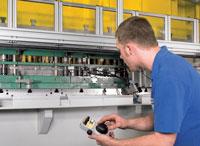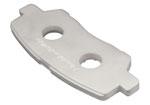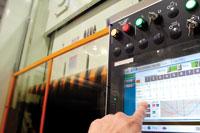Senior Editor
- FMA
- The Fabricator
- FABTECH
- Canadian Metalworking
Categories
- Additive Manufacturing
- Aluminum Welding
- Arc Welding
- Assembly and Joining
- Automation and Robotics
- Bending and Forming
- Consumables
- Cutting and Weld Prep
- Electric Vehicles
- En Español
- Finishing
- Hydroforming
- Laser Cutting
- Laser Welding
- Machining
- Manufacturing Software
- Materials Handling
- Metals/Materials
- Oxyfuel Cutting
- Plasma Cutting
- Power Tools
- Punching and Other Holemaking
- Roll Forming
- Safety
- Sawing
- Shearing
- Shop Management
- Testing and Measuring
- Tube and Pipe Fabrication
- Tube and Pipe Production
- Waterjet Cutting
Industry Directory
Webcasts
Podcasts
FAB 40
Advertise
Subscribe
Account Login
Search
The growth of the servo-driven press
Servo press sales have jumped in recent years--for a reason
- By Tim Heston
- April 22, 2013
- Article
- Bending and Forming

A technician dials in a setup on a servo press. With its programmable stroke, the press has opened up possibilities in metal forming. Photo courtesy of Schuler Incorporated.
A metal part from NUCAP, a global stamping supplier of automotive brake components, looks like a classic example of fineblanking, which produces blanks with machined-level precision. Thing is, the Toronto-based stamper didn’t make the part with fineblanking. Instead, it was made via a proprietary process the company calls FineblankPlus™, which offers the accuracy of fineblanking with a lot less scrap (see Figure 1). The tooling setup uses components that allow for precision trimming and shaving, but this die set won’t work on just any press; the manufacturer designed this tool for the servo-driven mechanical press.
The servo press remains a small portion of the overall stamping press market, but it’s growing like no other equipment category in the sector. According to a capital equipment survey from the Fabricators & Manufacturers Association Intl., servo press spending projections for 2013 were almost triple what they were the previous year. The industry still spends far more on mechanical presses, but the servo press is catching up fast.
“Over the past three years, there’s been a continuous interest in servo technology from the tier base,” said Barry Lewalski, sales and product manager, stamping and cutting technology, at Schuler Incorporated, Canton, Mich. “Everybody seems to be catching on to the reasoning as to why servo is so important. Even in the larger tonnage ranges, 98 percent of everything we quote involves a servo press.”
The industry’s push toward metal with high strength-to-weight ratios has gotten manufacturing engineers thinking about the servo press’s forming capabilities. Much of it boils down to the ability to control slide position and velocity—within microns.
“You can control the forming stroke,” said Lewalski, “and because you can control the forming stroke, you can control the speed, velocity, and overall performance and efficiency of the operation.”
Servo Press Basics
Instead of a flywheel, main motor, and clutch, a servo press uses a servomotor that in effect makes the slide a controllable axis (see Figure 2). In recent years pressmakers have offered different iterations, with different types of servos used in different places (see Figure 3). Whatever their specific design, all have approached the servo press design to overcome some inherent inefficiencies in the flywheel-clutch mechanical press.
In a traditional mechanical press, energy must be delivered from the flywheel through a clutch, down the connecting rods, which drive the ram that produces maximum tonnage at some point above bottom dead center. The main drive motor then has to get the flywheel back up to speed before the tool hits the material again. For this reason, the mechanical press’s stroke can’t be too slow, because the minimized speed of the flywheel won’t be able to provide enough energy to produce the needed force to cut through and form the metal. A press with a servomotor, however, can deliver maximum torque at any speed.
During a November company event, Toshiharu Suganuma, SEYI’s vice president of forming engineering, pointed to an image showing a stroke profile curve, illustrating the servo press’s high torque capabilities. “The electrical current provides the energy of the operation,” he said. “It’s about providing low RPMs and high torque. You can support programmable operation of the slide motion.”
The servo press is still a mechanical system and abides by a tonnage rating curve, so it cannot deliver full tonnage throughout the stroke, like a hydraulic press can. But a servomotor, unlike a flywheel, provides maximum torque almost immediately.
For years many smaller-tonnage servo presses have made their way to contract stampers serving aerospace, defense, and other high-tech sectors. In automotive, some OEMs—Toyota, for instance—have been using servo press technology for years. Now more automotive players are looking into the technology, especially as a way to form the high-strength materials that are becoming ever more common.

Figure 1: This part was produced with NUCAP’s FineblankPlus process. Instead of a fineblanking press, this process uses a servo press with proprietary tooling. Image courtesy of NUPCA
“Automotive is becoming a big driver. The industry is realizing the benefits of the technology,” said Shrinivas Patil, product manager at Dayton, Ohio-based AIDA-America. “With high-strength steel in a standard mechanical press, you can have a lot of scrap and experience a lot of reverse tonnage, which is bad for the press and bad for the tool.”
Benefits of Full Control
A servo press with a 7-in. stroke can efficiently form a part that may require only a 4-in. stroke. And within that stroke, the press slide can descend quickly; then move slowly the final quarter inch to make the form; and then return quickly to its 4-in. height, clearing the previously formed flanges.
“You’re able to work with material, not force it,” said Jim Landowski, vice president of the press technology division at Komatsu America Industries, Rolling Meadows, Ill.
This has especially benefited forming of high-strength material, which traditionally required the press to slow its strokes per minute. The servo has changed the situation. The motor speeds the slide to, say, 30 SPM prior to making contact with the material. Once the tool makes contact, the motor slows the slide, slowing the forming speed. As soon as the form is complete, the slide quickly returns. Sources added that the slower-moving slide (when the tool is in contact with the workpiece) causes less lateral movement of the punch and die. This improves cutting precision and prolongs tool life.
A programmable stroke also allows stampers to run different kinds of operations. “People like the versatility of being able to run a long-stroke operation and a short-stroke operation in the same press—in a servo press,” said Lee Ellard, national sales manager at Stamtec, Manchester, Tenn. “This gives people a lot more flexibility when it comes to the dies they can run in one press.”
Pressmakers have designed their systems to offer various capabilities at the bottom of the stroke, including dwell and pendulum actions. These features allow stampers to control the flow of metal, allowing the workpiece to settle. The dwell also makes it easier to incorporate in-die functions like staking and welding.
The control also allows for greater control when heating the die, as in specialized applications. At SEYI’s November event, a representative pointed to a slide showing how a servo press can tackle traditionally difficult workpieces. “The press stops for a few seconds for heating the die, in order to form materials such as magnesium, titanium, and aluminum alloys.”
As sources explained, controlling the slide motion affects friction, which in turn affects the amount of heat that goes into the part and die. Less heat input can mean longer tool life and, for the right application, different lubrication requirements. “Depending on the application, by slowing the slide at the point of contact, friction is reduced, and you may be able to change from a high-viscosity lubrication to a water-soluble one,” Landowski said. All this helps eliminate or simplify downstream processes. An in-die operation may eliminate downstream welding or assembly. A change in lubrication can simplify downstream parts cleaning.
Such slide programmability allows stampers to reduce the number of forming steps. A progressive die made for a traditional mechanical press might not need so many stations in a servo-driven machine—though, as sources emphasized, such benefits depend greatly on the application.
In a sense, the servo press has brought stampers into the digital realm. Digital control of the slide and die height creates consistency between presses. A die can be designed once for one press, and then used in another servo press anywhere. “You no longer have to spend weeks or months tweaking the tooling,” said Landowski.

Figure 2: In a servo press, the press slide in effect becomes a controllable axis. Image courtesy of AIDA-America.
Personnel can “dial in” setups. On certain systems, linear scales and other gauges feed information back in real time, so a press can, say, react quickly to changes in die height. In certain setups, linear scales can measure die height position with every stroke, plus or minus microns.
“Heat from the stamping operation can cause the frame to stretch slightly, so the die height can change throughout the day,” Landowski said. “So if there’s a change in die height, a signal is sent back to the system to make a slide adjustment.”
Consider a typical punching operation where the first portion of the material thickness cuts and then at a certain point breaks away, creating the snap-through load. Controlling the speed of the slide through the punching process—for example, strategically slowing the slide motion just before it touches the metal—helps limit snap-through load, so the press and tooling absorb less shock.
Press and Tool as a System
Of course, this alone wasn’t what allowed NUCAP to develp its FineblankPlus process. It also has proprietary tooling. The process requires a system—both the servo-driven mechanical press and the tooling—to work.
Servo presses certainly can use tools designed for a mechanical press, but those tools may not be able to take full advantage of the servo press’s fully controllable stroke and tighter tolerances. “I’ve gone through this for years,” Landowski said. “These presses have revolutionized the stamping process, but tool builders are still learning how to use the technology.”
This is perhaps one reason that NUCAP, with tool design as its core competency, has had such success. The stamper has roots in fineblanking going back to the 1970s.
“Fineblanking is a great technology,” said Montu Khokhar, vice president of global business development. “It can give you a part that is almost of machined-level quality. But it reached its limit as far as its capability, because you were limited by its speed of blanking, thickness, and the amount of scrap you needed to leave around the cut edges.
“I can’t go into detail about how exactly we make this,” he added. “But I can tell you about the final result of the process. We can achieve a perfect, 90-degree cut surface. We scrap less material, and we can run much faster than fineblanking. And we eliminate [part edge] rollover as well.
“We developed this process around the servo press,” he added. “It was a combination of controlling the cutting speed at specific points throughout the stroke and of utilizing the gas springs in the die, as well as controlling the holding pressures and cutting parameters.”
The company, which specializes in brake components for automotive, now has 10 gap-frame servo presses in three plants, and it has plans to continue installing more presses. Regardless, Khokhar emphasized that the process works not just because of the press, and not just because of the tooling, but because both the press and tooling work together so well.
About the Author

Tim Heston
2135 Point Blvd
Elgin, IL 60123
815-381-1314
Tim Heston, The Fabricator's senior editor, has covered the metal fabrication industry since 1998, starting his career at the American Welding Society's Welding Journal. Since then he has covered the full range of metal fabrication processes, from stamping, bending, and cutting to grinding and polishing. He joined The Fabricator's staff in October 2007.
subscribe now

The Fabricator is North America's leading magazine for the metal forming and fabricating industry. The magazine delivers the news, technical articles, and case histories that enable fabricators to do their jobs more efficiently. The Fabricator has served the industry since 1970.
start your free subscription- Stay connected from anywhere

Easily access valuable industry resources now with full access to the digital edition of The Fabricator.

Easily access valuable industry resources now with full access to the digital edition of The Welder.

Easily access valuable industry resources now with full access to the digital edition of The Tube and Pipe Journal.
- Podcasting
- Podcast:
- The Fabricator Podcast
- Published:
- 04/16/2024
- Running Time:
- 63:29
In this episode of The Fabricator Podcast, Caleb Chamberlain, co-founder and CEO of OSH Cut, discusses his company’s...
- Trending Articles
Capturing, recording equipment inspection data for FMEA

Tips for creating sheet metal tubes with perforations

Are two heads better than one in fiber laser cutting?

Supporting the metal fabricating industry through FMA

Hypertherm Associates implements Rapyuta Robotics AMRs in warehouse

- Industry Events
16th Annual Safety Conference
- April 30 - May 1, 2024
- Elgin,
Pipe and Tube Conference
- May 21 - 22, 2024
- Omaha, NE
World-Class Roll Forming Workshop
- June 5 - 6, 2024
- Louisville, KY
Advanced Laser Application Workshop
- June 25 - 27, 2024
- Novi, MI



























